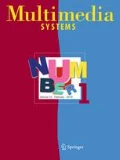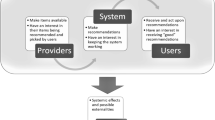Abstract
This paper presents an innovative consumption-modeling system applied to digital TV, able to infer the user interest regarding the TV contents. The user interest inferred is used to feed content recommender systems, and it has been tested in real scenarios involving real users. The modeling system uses as input the TV consumption data and performs an algorithm based on a Hidden Markov Model and Bayesian inference techniques to infer the said user interest. Real data have been picked up in real time to feed our modeling, and the final results have been checked comparing with user’s tastes, which have been expressed through a set of questionnaires and the whole system has been tested in a TV broadcasting scenario with real users. Conclusions show that our system improves the reliability from classic user interest modeling systems (they are mainly based on explicit opinion based methods, which can be intrusive for general users and could show certain deceptive results, as it is described in this paper).











Similar content being viewed by others
References
Shin, H., Lee, M., Kim, E.Y.: Personalized digital TV content recommendation with integration of user behavior profiling and multimodal content rating. IEEE Trans. Consum. Electron. 55(3), 1417–1423 (2009)
Yu, Z., Zhou, X., Zhou, L., Du, K.: A hybrid similarity measure of contents for TV personalization. Multimed. Syst. 16(4–5), 231–241 (2010)
Tanveer Syeda-Mahmood, D.P.: Learning video browsing behavior and its application in the generation of video previews. International Multimedia Conference. Proceedings of the ninth ACM international conference on Multimedia. Ottawa, Canada (2001)
Zimmerman, J., Kurapati, K., Buczak, A.L., Schaffer, D., Gutta, S., Martino, J.: TV personalization system. Chapter 5. Design of a TV Show Recommender Engine and Interface (2004)
Billsus, D., Pazzani, M.J.: Learning collaborative information filters, pp. 46–54. Fifteenth International Conference on Machine Learning, Wisconsin (1998)
Duda, R., Hart, P.: Pattern recognition and scene analysis. Wiley, New York (1973)
Quinlan, R.: Learning efficient classification procedures and their application to chess end games. In: Michalski, R.S., Carbonell, J.G., Mitchell, T.M. (eds.) Machine learning: an artificial approach, vol. 1. Morgan Kaufmann Publishers Inc., Palo Alto (1983)
Sollenborn, M., Funk, P.: Category-based filtering and user stereotype cases to reduce the latency problem in recommender systems. In: Craw, S., Preece, A.D. (Eds.) Advances in Case-Based Reasoning, 6th European Conference, ECCBR 2002Aberdeen, Scotland, UK, September 4-7, 2002, Proceedings, vol. 2416 of Lecture Notes in Computer Science. pp. 395–420, Springer (2002)
Martin-Vicente, M.I., Gil-Solla, A., Ramos-Cabrer, M., Blanco-Fernandez, Y., Lopez-Nores, M.: A semantic approach to avoiding fake neighborhoods in collaborative recommendation of coupons through digital TV. IEEE Trans. Consum. Electron. 56(1), 54–62 (2010)
Shani, G., Meisles, A., Gleyzer, Y., Rokach, L., Ben-Shimon, D.: A stereotypes-based hybrid recommender system for media items. Workshop on Intelligent Techniques for Web Personalization, Vancouver (2007)
Álvarez, F., Martín, C.A., Alliez, D., Roc, P.T., Steckel, P., Menéndez, J.M., Cisneros, G., Jones, S.T.: Audience measurement modeling for convergent broadcasting and IPTV networks. IEEE Trans. Broadcast. 55(2), 502–515 (2009)
Piesing, J.: The DVB Multimedia Home Platform (MHP). The Institution of Electrical Engineers, IEEE Savoy Place, London (1999)
Merkel, K.: Hybrid broadcast broadband TV, the new way to a comprehensive TV experience, Electronic Media Technology (CEMT), 2011 14th ITG Conference on, vol., no., pp. 1–4, 23–24 March (2011)
Qingjun Wang, Zhihong Wu: Research into application of TV-anytime standard on digital Televisions, Artificial Intelligence, Management Science and Electronic Commerce (AIMSEC), 2011 2nd International Conference on, vol., no., pp. 6318–6321, 8–10 August (2011)
Bradburn, N.M., Sudman, S., Wansink, B.: Asking questions: the definitive guide to questionnaire design—for market research, political polls, and social and health questionnaires, Revised Edition. ISBN: 978-0-7879-7088-8. April (2004)
Acknowledgments
The work presented in this paper was partially supported by the EU-funded FP7 project nextMEDIA (ICT-249065) and the Spanish national projects BUSCAMEDIA (CEN- 20091026) and MIREIA (IPT-2011-2015-430000).
Author information
Authors and Affiliations
Corresponding author
Rights and permissions
About this article
Cite this article
Sanchez, F., Barrilero, M., Alvarez, F. et al. User interest modeling for social TV-recommender systems based on audiovisual consumption. Multimedia Systems 19, 493–507 (2013). https://doi.org/10.1007/s00530-013-0312-6
Published:
Issue Date:
DOI: https://doi.org/10.1007/s00530-013-0312-6




